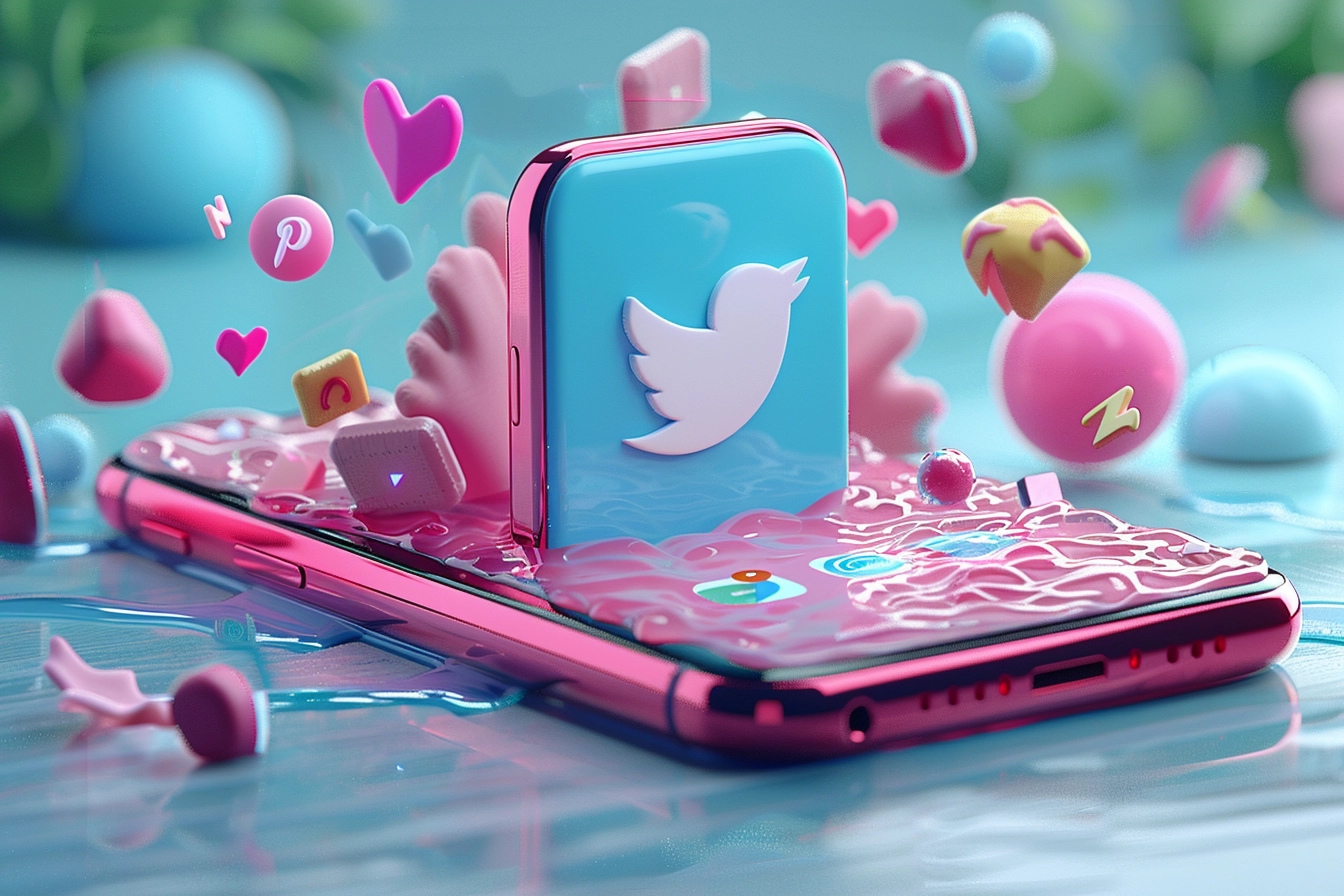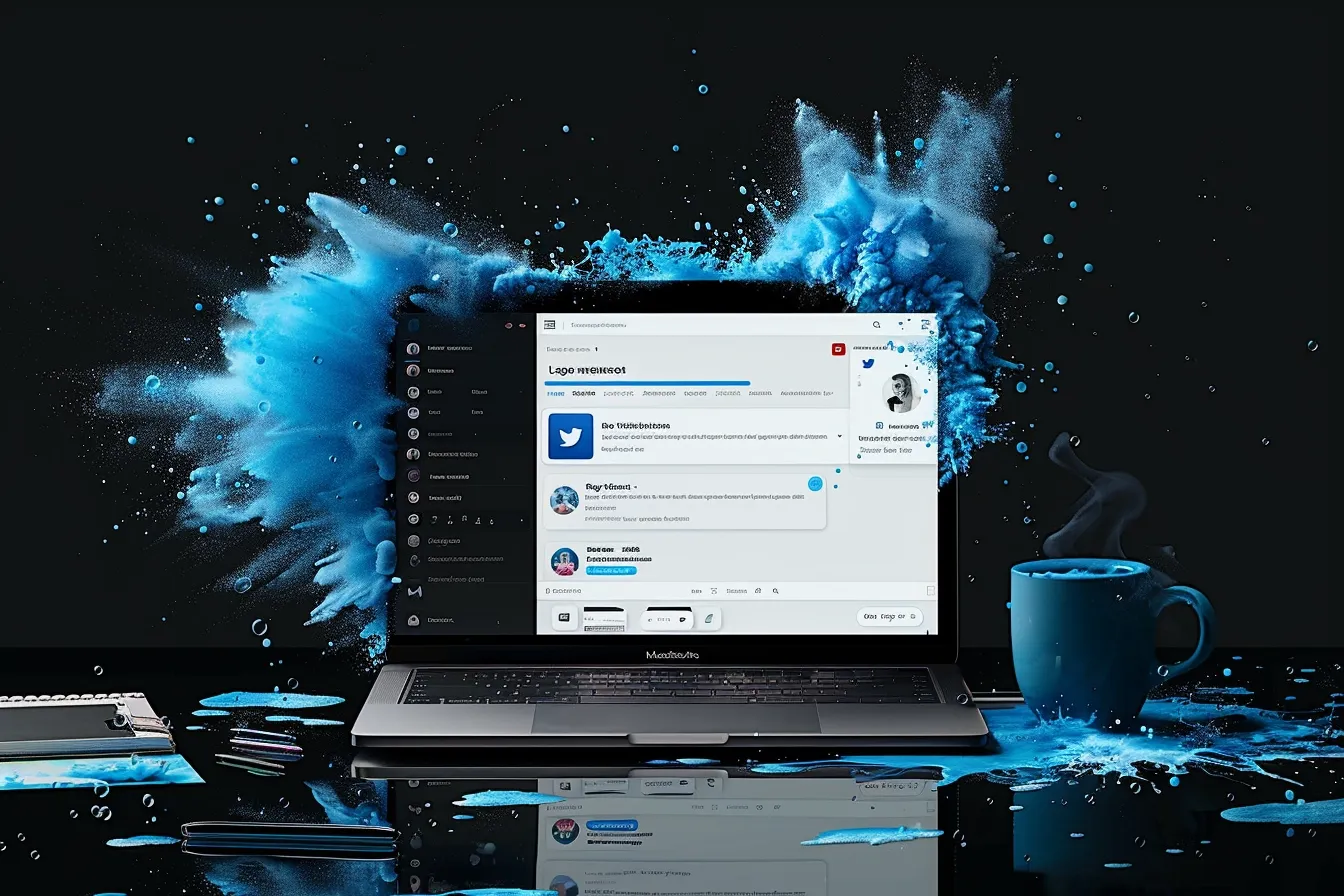The Psychological Influence of Blue in Branding
Blue is a prominent color among the wide range of colors used in branding and marketing, which is evidence of its strong psychological influence and widespread appeal. This predilection is based on a thorough grasp of color psychology and how it influences consumer behavior, not just happenstance. As one of the most well-known companies on the internet, Twitter is a fascinating case study in smart color choice because of the way it has skillfully used blue to define its brand.

The Blue Color’s Universal Appeal
In nature, blue is a color that inspires sentiments of communication, trustworthiness, and reliability. It may be seen in both the sky above and the ocean below. Because blue is universally embraced by all cultures and ethnicities, it is a safe and desirable option for companies looking to have a significant impact. By leveraging these innate connections, Twitter’s decision to make blue its primary brand color helps to create a trustworthy and dependable atmosphere on the network.
Psychological Impact
The color blue has a significant and varied psychological effect. It eases tension, fosters peace and tranquility, and builds confidence and security. These attributes are extremely beneficial in the context of social media, where contact and engagement are crucial. By becoming blue, Twitter not only establishes a reputation for dependability and professionalism but also promotes user engagement and candid dialogue. This deliberate use of blue contributes to the creation of a virtual environment where people feel at ease exchanging ideas and holding conversations.
Explore the psychology behind color choices in branding:
Blue in Corporate Identity
Blue is frequently linked to intellect, stability, and professionalism in the business sector. In industries where dependability and trust are crucial, including finance, technology, and healthcare, this color is commonly used. Twitter has positioned itself as a reliable and authoritative source of information by adopting blue, which is consistent with the ideals of these sectors. In the digital era, when trustworthiness has a big influence on a platform’s reputation and usage, this alignment is especially important.

The Particular Blue Shade of Twitter
Twitter’s choice of particular blue also has a significant impact on its brand identity. Twitter’s blue color finds the ideal mix between being bright and dark, making it readable and visible in a variety of mediums. This specific shade embodies the dynamic but approachable essence of the platform, being simultaneously eye-catching and relaxing. Because it sticks out in the crowded social media space, Twitter’s logo is easily recognized among those of its rivals.
Twitter’s deliberate choice of blue as its trademark color stems from a profound comprehension of color psychology and how it impacts customer behavior. Twitter has established a brand identity that is consistent with its platform principles and psychological resonance with its audience by selecting a color that symbolizes communication, trust, and dependability. This strategic approach to branding highlights the significance of color in creating and preserving a brand’s identity in the digital era, providing insightful information for companies and marketers looking to engage their target consumers more deeply.
Historical Evolution and Strategic Considerations of Twitter’s Blue Brand Identity
With its signature blue color, Twitter’s brand design has evolved, telling a story of strategic change and an astute understanding of the pulse of digital culture. Gaining an understanding of this progression will help you better appreciate the brand’s dedication to staying relevant and connected in the rapidly changing digital world.

The Genesis of Twitter’s Branding
When Twitter first appeared online in 2006, it was competing with other social media sites for users’ attention in a crowded market. Its original logo’s bright, sky-blue color was purposefully chosen to stand out from the competition rather than just being aesthetically pleasing. This decision mirrored characteristics like transparency, lucidity, and inventiveness—elements that Twitter sought to represent as a medium enabling instantaneous communication worldwide.
Evolution through Rebranding
Subtle but substantial changes have been made to Twitter’s brand identity throughout time, each reflecting the platform’s expansion and the evolving nature of digital communication. Twitter evolved from a text-based network to a worldwide communication powerhouse, as seen by the growth of its distinctive blue bird, sometimes known as “Larry the Bird,” from a basic typographic logo. Every revision of the logo and related color scheme was done with a purpose, to improve user identification and solidify the brand’s standing in the social media hierarchy.
The evolution of Twitter’s blue over time to become the particular shade that has come to represent the brand demonstrates a growing comprehension of the color’s influence on user interaction and perception of the brand. This progression shows how to reconcile keeping a consistent brand identity with responding to the changing demands of customers and the online market.

Strategic Considerations Behind the Blue
Twitter’s unwavering devotion to blue is based on tactical factors that go beyond visual appeal. The leadership of the platform realized early on that a key component of its visual communication strategy would be the brand’s color. The chosen shade of blue has to be eye-catching enough to draw attention while communicating the platform’s basic ideals of open communication, dependability, and trustworthiness in an era of digital devices and short user attention spans.
Furthermore, in the congested world of social media, that particular shade of blue acts as a visual anchor, promoting brand recall and awareness. Additionally, it makes it easier for customers to have a consistent brand experience across a variety of touchpoints, including websites, mobile apps, marketing collateral, and business communications. Maintaining this branding consistency is essential to creating a powerful, identifiable brand identity that appeals to consumers all across the world.
Read about the Science behind the brand’s designs:
The Significance of Colour in Interface Design and User Experience
Twitter uses blue across its user interface and general design language, not only in its logo. The design team of the platform has skillfully used several tones of blue to produce a visually pleasing and simple-to-use interface. Because of the color’s relaxing properties, it’s especially useful in often hectic and fast-paced environments. Twitter has developed a digital habitat that promotes constant involvement by using blue as its dominant color. This helps users feel comfortable as they travel through a sea of tweets and exchanges.

A systematic and comprehensive approach to branding may be seen in the historical development and strategic considerations that went into creating Twitter’s blue brand identity. Through the persistent use of blue’s psychological appeal and shade adaptation to improve user experience and brand awareness, Twitter has established itself as a dominant player in the digital communication market. In addition to reflecting its core principles, the brand’s dedication to its blue identity shows that it has a deep appreciation for the significance of color in digital branding.
Learn more about the use of blue in branding:
Using Colour to Increase User Engagement
There is ample evidence about the psychological effects of color on human behavior. Blue is frequently linked to feelings of tranquility, dependability, and trust. This color is brilliantly used by Twitter in design psychology, fostering an atmosphere that tempts users to spend more time on the network. Twitter blue’s soothing and inviting color is quite effective at lowering visual fatigue, which makes it easier and less taxing on the eyes to browse through feeds, read tweets, and interact with information.

Furthermore, by sticking with a blue color scheme, Twitter is better able to stand out from other social media sites, many of which utilize more eye-catching, bright color schemes. In a crowded market, where retaining users’ interest is just as important as grabbing their attention in the first place, this differentiator is essential. Hence, Twitter’s blue is more than simply a color; it’s a tactical instrument that boosts user engagement by offering a visually harmonious and soothing user experience that sets it apart from the competitors.
Fostering Brand Loyalty
In the digital era, emotional ties to a brand are just as important as the services’ practicality in retaining customers. The blue color of Twitter plays a crucial role in creating an emotional connection between the company and its consumers.
Get more information about emotional branding:
Twitter’s user base has developed a strong sense of community and belonging by constantly utilizing a color that inspires sentiments of trust and reliability. It takes an emotional commitment to keep people on the site and motivate them to come back again.

A key element of brand loyalty is brand identification, which is reinforced by Twitter’s consistent use of its signature blue color. The user’s bond with the platform becomes stronger with each encounter they have with the brand, which strengthens these psychological connections. Because of the constant branding over all touchpoints, Twitter has a more recognizable and comforting presence online, which encourages users to continue with the platform rather than switching to rivals.
The Function of Blue in Accessibility and Content Visibility
The platform’s functionality is also strategically employed with Blue, especially in terms of improving accessibility and exposure of information. Carefully calibrated contrast between Twitter’s blue parts and white backdrop makes information easy to see and interact with. This is important to take into account since it guarantees that users of a platform that mostly depends on text-based communication may comfortably interact with material for longer periods.
Furthermore, Twitter’s dedication to usability and accessibility is further demonstrated by the usage of blue hyperlinks, which is a normal online convention. Blue links are distinct from text and let users navigate the platform easily, from reading tweets to browsing related content. Encouraging more in-depth investigation and interaction with the information, not only improves the user experience but also raises engagement and lengthens the time spent on the site.
The influence of Twitter’s blue on brand loyalty and user engagement is evidence of the importance of color in digital branding. Twitter has developed a user experience that generates a devoted user base, enables longer engagement periods, and fosters emotional relationships by utilizing the psychological connotations of blue. Twitter’s success as a worldwide communication network has been greatly attributed to its strategic use of color, clever interface design, and consistent branding.

Broader Implications for Digital Branding Strategies
In addition to providing a model for successful digital branding, Twitter’s deft use of blue in its brand identity also offers a case study for how colors may be strategically used to influence user perceptions and behavior online. Insights into the significance of color in building a strong online presence and lessons for other brands looking to make an impact in the digital space are provided below.
The Artful Use of Colour in Digital Brand Identity
Choosing colors carefully is essential to creating a digital brand identity that connects with the target market and stands out in a crowded field. Twitter’s success story emphasizes how important it is to have a carefully considered color scheme that complements the brand’s objectives and values. When a brand enters the digital realm, color selection should be thoughtful, taking into account cultural factors, market research, and color psychology. By using this method, the colors chosen will certainly not only improve visual appeal but also strengthen the brand message and create an emotional bond with the target audience.
Distinctiveness and Identifiability of Brands
The capacity to set one’s brand apart becomes essential in the digital era, as people are inundated with information from many sources. As Twitter has shown, color can be a very effective method for accomplishing this separation. In a sea of rival brands, a unique color scheme may help increase brand recognition by making it simpler for consumers to recognize and remember the company. Investing in a distinctive color identity is crucial for both new and existing firms to carve out a position in the digital ecosystem and build enduring brand loyalty.

Improving Accessibility and User Experience
Twitter’s deliberate usage of blue goes beyond branding to affect accessibility and the platform’s general user experience. This emphasizes how crucial it is to incorporate color concerns into the design and user interface processes. Color schemes that complement a brand’s identity and enhance the user experience should be given top priority by brands. The design approach should be guided by elements like contrast, readability, and color harmony to make sure the digital platform is interesting and inclusive for all users.
Discover how visual harmony plays an important role in a brand’s success:
Implications for Marketing and Communication Strategies
A brand’s color palette has a big impact on its marketing and communication plans. For instance, Twitter uses blue extensively in all of its marketing materials in addition to its logo, which helps to establish a consistent and recognizable brand presence across a range of media. To maximize the impact of their marketing campaigns, brands should make use of their color schemes. Color can be used to attract attention, arouse feelings, and communicate ideas. A brand’s voice and messaging may be amplified and made more memorable by using color consistently and strategically.
Brands navigating the digital world may learn a lot from the science underlying Twitter’s blue brand identity. Color is a powerful tool for digital branding since it may affect user behavior, improve brand identification, and create a cohesive brand experience. Twitter’s deliberate usage of blue serves as an example of how careful consideration when choosing colors may boost a brand’s popularity by encouraging user interaction and loyalty. Given how quickly businesses are changing in the internet sphere, it is crucial to include color psychology and strategy in digital branding initiatives, as demonstrated by Twitter’s branding journey. Brands can stand out in a digital age that is driven by innovation and connectedness by doing this and forging deep relationships with their audience



